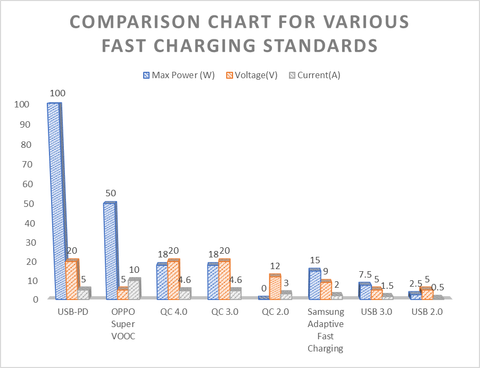-
Fast charging standards
Because fast charging can be theoretically accomplished by varying current and voltage to any extent, it makes sense to implement a universal standard that fosters cross compatibility and ease of usage. Several of such standards exist with the two most popular being USB Power Delivery (USB-PD) and Qualcomm Quick Charge (QC).
USB-PD as a fast charging standard was developed by USB-IF, the same organization responsible for the USB standard as a whole. This rapid charging protocol can deliver up to 100W of power by alternating variable voltage capped at 20V and current capped at 5A. It requires a compatible USB port (specifically USB-C) cable.

Since a massive chunk of devices today ship (from Google’s Pixel 3/3 XL, to the iPhone Xs/Xs Max to the MacBook/MacBook Pro) by default with both prerequisites, USB-PD technology is arguably the most prevalent fast charging standard. Note that other versions of USB technology come with their correspondent fast-charging protocol, just like USB C. USB 3.0 present in some variants of the Samsung Galaxy S5 for instance, is capable of delivering 4.5W (5V/09A).
Qualcomm was one of the tech industry’s earliest debutants of fast charging with its Quick Charge protocol. Its latest version is capable of producing a max power output of 18W by varying voltage capped at 20V and current capped at 4.6A. Note that this is not the maximum power it can provide, but since QC was originally intended for smartphones (not laptops) which rarely need above 20W, this configuration works just fine.
Honorary mention goes to Oppo’s Super VOOC and Samsung’s Adaptive Fast Charging. Both operate similarly to USB-PD and are available in their manufacturer’s electronic devices only.
Comparing both USB-PD and QC fast charging standards seems to tip the bias towards USB-PD since it is widely more compatible. USB-PD allows you to charge a broad range of devices with just one charger – if you have, say, an Apple iPhone Xs/Xs Max, a 2018 MacBook/MacBook Pro and an iPad, you don’t need to pack separate chargers for each device when traveling. Any of your device chargers’ should support the rest. Qualcomm’s QC, on the other hand, will only work with a device powered by a Qualcomm processor. That’s not to mention that Qualcomm’s QC supports USB-PD by default, with even higher output power in the USB-PD mode.

So, as a way of conclusion, given the antecedents, would it makes sense to procure additional USB-PD fast charging gear, as opposed to going the QC way? Certainly yes. As USB-IF has shown with USB-PD, it leads the frontier for fast charging technology. Investing in a USB-PD charger or power bank is a way to ensure your charging rig stays relevant for years to come. Plus with Qualcomm now supporting USB-PD it will stay relevant even for Qualcomm based devices. That’s killing two birds with one stone.
Along with your iPad Pro, charge numerous other devices as well. VogDUO Charger Go also comes with USB-A port that provides 12 watts of power for you to connect your iPhone or iPad for instant charging.
Get Power Delivery with 45W USB-C port along with 12W USB-A port. Instant charging now made available by VogDUO Charger Go within minutes in the most effective and efficient ways. Charge iPod mini, Macbook Pro, MacBook, Nintendo Switch, smartphones, tablets and other electronic devices that are USB-C enabled.



